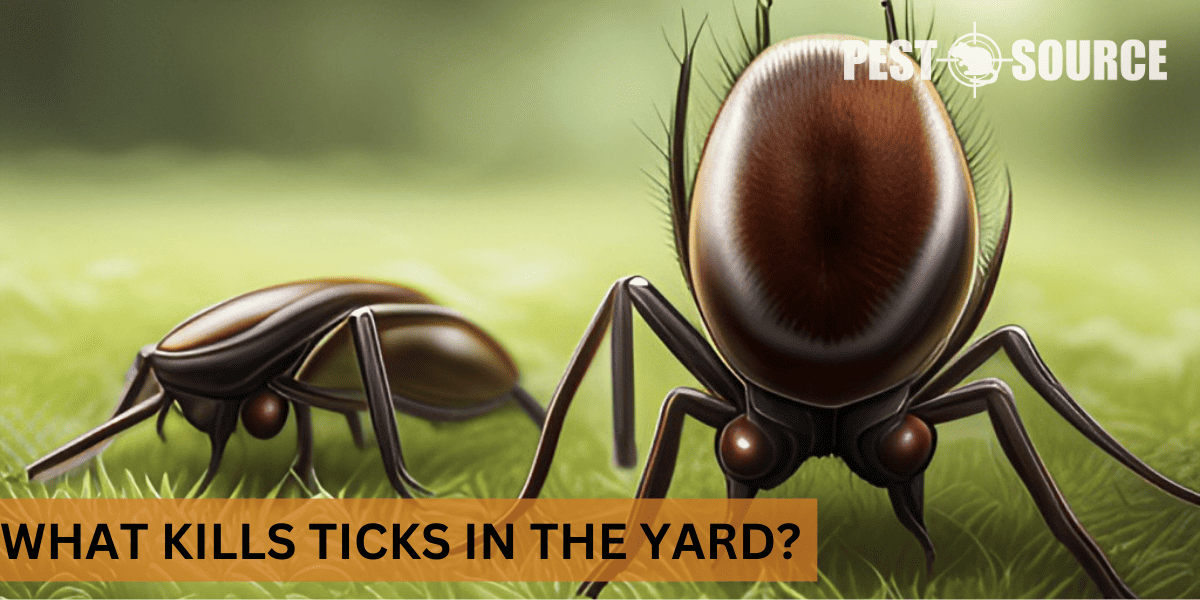Ticks pose a significant threat to both our health and our outdoor enjoyment. They thrive in many environments, and unfortunately, yards are among their favorites. Their small size, coupled with the health risks they pose—like Lyme disease—makes them a formidable foe. However, with proper knowledge and action, you can turn your yard into a place where ticks are not welcomed.
This comprehensive guide explores what causes tick infestation, how to eliminate ticks from your yard, and the ongoing steps you can take to maintain a tick-free environment. Whether you’re dealing with a current tick problem or looking to prevent future infestations, read on to learn how to reclaim your yard from these pesky pests.
POINTS
- Ticks can be attracted to your yard by the presence of dense vegetation, leaf litter, certain wildlife, and domestic animals. Keeping a clean, well-maintained yard can decrease the probability of an infestation.
- For immediate tick control in your yard, chemical pesticides, and natural home remedies such as diatomaceous earth can be effective. However, steps should be taken to ensure the safe and responsible use of these substances.
- In addition to immediate solutions, there are long-term tick control strategies, including regular lawn treatment, landscaping changes, and measures for large properties. These methods disrupt the life cycle of ticks and create unfriendly environments for them.
- Certain plants can naturally deter ticks, while encouraging tick predators like chickens, certain bird species, and nematodes can help in biological control. Integrating these natural methods with other control strategies can enhance their effectiveness.
- Regular inspection for ticks on family members and pets, combined with constant monitoring and maintenance of the yard, plays a crucial role in preventing future infestations. Prevention is equally, if not more, important as extermination in maintaining a tick-free yard.
Understanding Ticks in the Yard
Ticks can be a nuisance in your yard and may pose a significant health risk, carrying diseases like Lyme. But how do they end up in our yards in the first place? What signs should you look for, and how do animals play a role in infestation?
What Causes Ticks in the Yard?
Ticks thrive in certain environments—tall grass, shrubbery, or any place where they have ample cover and access to wildlife for blood meals. If your yard has a lot of brush, tall grass, leaf litter, or is adjacent to a heavily wooded area, this could attract ticks. Ticks also need a host—animals such as mice, birds, deer, and even our pets can bring them into our yard.
How Can You Identify a Tick Infestation in Your Yard?
Ticks are tiny and stealthy and often go unnoticed until they’ve become a problem. However, there are some signs of a possible tick infestation. Frequent tick bites on family members or pets, spotting ticks on outdoor furniture or equipment, and having a yard that attracts deer or rodents can all indicate a possible infestation.
What Role Do Animals Play in Tick Infestation?
Animals play a significant role in tick infestations. Rodents, deer, birds, and our pets can serve as the vehicle for ticks to enter our yards. They hitch a ride on these animals and disperse throughout the yard where they lay eggs, increasing their population. Controlling these animals and making your yard unattractive to them can significantly reduce the risk of tick infestation.
Immediate Solutions for Tick Control
Once you’ve identified a tick infestation in your yard, it’s time to take immediate action. Let’s delve into the immediate solutions for tick control which range from chemical solutions to DIY home remedies.
What Kills Ticks Instantly?
Chemical pesticides are often the first line of defense and can kill ticks instantly. Products containing ingredients like permethrin, cyfluthrin, or carbaryl can be very effective. However, always follow the manufacturer’s instructions to ensure you apply these products safely and responsibly. Remember, chemical pesticides should be part of an integrated pest management approach, not a standalone solution.
What Chemicals or Pesticides Can Kill Ticks?
Several chemicals and pesticides can kill ticks. Carbaryl, typically sold under the brand name Sevin, is one of the most commonly used insecticides for tick control. Other effective chemicals include Bifenthrin and Permethrin. While these pesticides can be highly effective against ticks, they should be used by professionals or under professional guidance due to their potential impact on non-target organisms and the environment.
How Effective is Spraying for Ticks Outside?
Spraying for ticks in the yard can be an effective method to instantly reduce tick populations, particularly when the infestation is severe. It’s most effective when combined with other methods, such as regular yard maintenance and landscaping adjustments. However, the effectiveness can vary based on the product used, the manner of application, and the extent of the infestation.
What Home Remedies are Available for Ticks?
There are also several DIY remedies that homeowners can use. Diatomaceous earth is a non-toxic powder, deadly to ticks. You sprinkle it around your yard, especially in areas where you’ve seen ticks. However, remember it needs to be re-applied after a heavy rain. Certain natural repellents, such as oils from eucalyptus, lemon, and cedar, can also deter ticks. These remedies, while not as powerful as chemical pesticides, can add an extra layer of defense against ticks.
Different Approaches for Treating Your Yard for Ticks
Having considered immediate solutions, let’s now turn our focus to different methods for treating your yard over an extended period.
What Are the Best Ways to Treat Your Yard for Ticks?
Treating your yard for ticks involves a multi-pronged approach: use of pesticides, fostering natural predators, maintaining a well-groomed yard, and efficient use of landscaping techniques to create an unwelcoming environment for ticks.
How Can You Use Tick Tubes for Yard Treatment?
Tick tubes can be effective tools for managing tick populations. They contain cotton balls treated with a tick-killing chemical, Permethrin. Mice, a primary host for ticks, collect the treated cotton for their nests, thereby exposing ticks to the lethal chemical. However, tick tubes should be deployed carefully and strategically for maximum effectiveness.
Can You Spray Your Yard for Ticks and How Effective is This Method?
Spraying your yard is one of the most widely used methods for tick control. It can be effective in drastically reducing tick populations. However, the efficiency of this method can vary based on factors such as size and condition of your yard, and the extent of the tick infestation. A professional pest control service is recommended to ensure safety and effectiveness.
What’s the Role of Diatomaceous Earth in Tick Control?
Diatomaceous earth (DE), made from crushed fossils of aquatic organisms, is a natural and safe method of tick control. DE inflicts physical damage to ticks’ exoskeletons, which ultimately lead to their death. This powder can be spread around your yard, focusing especially on hotspots of tick activity. It’s a slow-acting, yet effective tool, and must be reapplied after rain or heavy dew since moisture can reduce its effectiveness.
Biological Control and Natural Methods for Tick Eradication
In addition to chemical means of controlling ticks, there are biological control methods and natural deterrents that can assist in tick eradication.
How Can Biological Control Assist in Tick Eradication in Your Yard?
Biological control uses nature’s own mechanisms to control pest populations. There are several creatures like chickens, guinea fowl, and certain types of birds that are known to feast on ticks. Similarly, nematodes, small worm-like creatures, can be introduced into your yard as they actively seek out and kill ticks.
What Natural Repellents Can Deter Ticks?
There are natural repellents that can be used to deter ticks from your yard. Certain essential oils, for instance, eucalyptus and lemon, have been found to repel ticks. Others have successfully used a mixture of vinegar and water. However, these remedies tend not to be as long-lasting as chemical treatments and need frequent application.
What Plants Help in Keeping Ticks Away from the Yard?
Certain plants naturally repel ticks. These include garlic, lavender, mint, and rosemary. By incorporating these into your landscaping, you provide a natural deterrent to ticks. These plants have the added benefit of being desirable additions to any garden, offering a variety of colors, fragrances, and culinary uses.
Tick Control Through Landscaping and Maintenance
Not only does a well-maintained and landscaped yard enhance the aesthetics of your property, but it can also play a crucial role in controlling tick infestations.
How Can Reduced Vegetation and Regular Maintenance Help Deter Ticks?
Ticks flourish in dense vegetation where they can easily latch onto passing hosts. By reducing the amount of overgrowth, you limit their habitat. Keep the grass cut short and trim trees and shrubs to allow more sunlight in, as ticks prefer damp, shady areas.
How Can Landscaping Be Used to Control Ticks?
Specific landscaping strategies can significantly deter ticks. Create a buffer of gravel or wood chips between your lawn and nearby wooded areas to prevent ticks from migrating into your yard. Planting deer-resistant foliage can also restrict tick migration, as deer are known to be significant carriers of ticks.
What Role Does Leaf Litter and Debris Play in Tick Infestation?
Leaf litter and garden debris can create a humid environment that is perfect for ticks. Keeping your yard free of leaf litter, piled grass cuttings, and other garden debris can disrupt a tick’s optimal living conditions, thereby controlling their population. Regular yard clean-up is vital in maintaining a tick-free yard.
Long-term Strategies and Preventive Measures for Tick Control
Beyond immediate action, implementing long-term strategies and preventive measures helps ensure you keep a tick-free yard and avoid future infestations.
What Are the Best Ways to Prevent Tick Infestation in the Yard?
The best preventive measures include maintaining a clean and well-groomed yard, using tick tubes appropriately, application of pesticides during tick season, implementing landscaping strategies that deter ticks, and introducing tick predators in your yard. Regularly checking for ticks on family members and pets also helps identify any potential infestation earlier, making control efforts more effective.
How Can You Keep Ticks Out of Your Yard Permanently?
Keeping ticks out permanently is challenging, considering many factors such as surrounding environment and wildlife are beyond your control. However, a combination of steps such as maintaining low vegetation, regular yard cleanup, proper use of pesticides or natural repellents, and biological control methods can keep your yard tick-free in the long run.
What Role Does Regular Lawn Treatment Play in Tick Prevention?
Regular lawn treatment plays a significant role in tick prevention. This includes consistent lawn mowing, gathering and removal of garden debris, and seasonal pesticide applications. These ongoing efforts can disrupt tick lifecycle, reduce their populations, and maintain a less hospitable environment for ticks. Continual lawn treatment is key in preventing future tick infestations.
Treating Large Properties for Ticks
Bigger properties or those adjacent to tick-prone areas often face greater challenges when it comes to tick control. Here’s how you can deal with ticks on large tracts of land.
How to Get Rid of Ticks on Large Property?
The same strategies for small properties apply to large properties, but they often require additional effort. Regular yard maintenance is crucial, particularly near dwelling areas. You can apply tick tubes or pesticides on a larger scale, focusing on areas closest to your home first. Consider professional pest control services as they’re equipped to treat large properties effectively.
What Is the Best Treatment for Ticks on Large Areas of Land?
There’s no one-size-fits-all solution when it comes to treating large areas for ticks. However, a combination of pesticide application, use of tick tubes, biological control, and consistent landscaping and maintenance can be effective. Depending on the size of the area and severity of the infestation, it could be best to consider hiring a professional pest control service. They have access to commercial-grade pesticides and have the experience to ensure maximum effectiveness while adhering to safety protocols.
Conclusion: Comprehensive Strategies for Tick Control
While ticks can be a challenging pest, a combination of knowledge, the right tools, and consistent action can help you maintain a tick-free yard. Be vigilant, persistent, and remember that preventing ticks is equally, if not more important, as controlling them.



